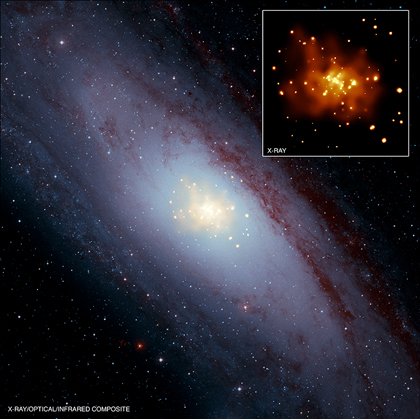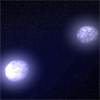For Release: February 17, 2010
NASA

Credit: X-ray (NASA/CXC/MPA/M.Gilfanov & A.Bogdan), Infrared (NASA/JPL-Caltech/SSC), Optical (DSS))
Press Image and Caption
WASHINGTON -- New findings from NASA's Chandra X-ray Observatory have provided a major advance in understanding a type of supernova critical for studying the dark energy that astronomers think pervades the universe. The results show mergers of two dense stellar remnants are the likely cause of many of the supernovae that have been used to measure the accelerated expansion of the universe.
These supernovae, called Type Ia, serve as cosmic mile markers to measure expansion of the universe because they can be seen at large distances, and they follow a reliable pattern of brightness. However, until now, scientists have been unsure what actually causes the explosions.
"These are such critical objects in understanding the universe," said Marat Gilfanov of the Max Planck Institute for Astrophysics in Germany and lead author of the study that appears in the Feb. 18 edition of the journal Nature. "It was a major embarrassment that we did not know how they worked. Now we are beginning to understand what lights the fuse of these explosions."
Most scientists agree a Type Ia supernova occurs when a white dwarf star -- a collapsed remnant of an elderly star -- exceeds its weight limit, becomes unstable and explodes. Scientists have identified two main possibilities for pushing the white dwarf over the edge: two white dwarfs merging or accretion, a process in which the white dwarf pulls material from a sun-like companion star until it exceeds its weight limit.
"Our results suggest the supernovae in the galaxies we studied almost all come from two white dwarfs merging," said co-author Akos Bogdan, also of Max Planck. "This is probably not what many astronomers would expect."
The difference between these two scenarios may have implications for how these supernovae can be used as "standard candles" -- objects of a known brightness -- to track vast cosmic distances. Because white dwarfs can come in a range of masses, the merger of two could result in explosions that vary somewhat in brightness.
Because these two scenarios would generate different amounts of X-ray emission, Gilfanov and Bogdan used Chandra to observe five nearby elliptical galaxies and the central region of the Andromeda galaxy. A Type 1a supernova caused by accreting material produces significant X- ray emission prior to the explosion. A supernova from a merger of two white dwarfs, on the other hand, would create significantly less X-ray emission than the accretion scenario.
The scientists found the observed X-ray emission was a factor of 30 to 50 times smaller than expected from the accretion scenario, effectively ruling it out. This implies that white dwarf mergers dominate in these galaxies.
An open question remains whether these white dwarf mergers are the primary catalyst for Type Ia supernovae in spiral galaxies. Further studies are required to know if supernovae in spiral galaxies are caused by mergers or a mixture of the two processes. Another intriguing consequence of this result is that a pair of white dwarfs is relatively hard to spot, even with the best telescopes.
"To many astrophysicists, the merger scenario seemed to be less likely because too few double-white-dwarf systems appeared to exist," said Gilfanov. "Now this path to supernovae will have to be investigated in more detail."
In addition to the X-rays observed with Chandra, other data critical for this result came from NASA's Spitzer Space Telescope and the ground-based, infrared Two Micron All Sky Survey. The infrared brightness of the galaxies allowed the team to estimate how many supernovae should occur.
NASA's Marshall Space Flight Center in Huntsville, Ala., manages the Chandra program for NASA's Science Mission Directorate in Washington. The Smithsonian Astrophysical Observatory controls Chandra's science and flight operations from Cambridge, Mass.
More information, including images and other multimedia, can be found at:
http://chandra.harvard.edu and http://chandra.nasa.govMedia contacts:
J.D. Harrington
NASA Headquarters, Washington
202-358-5241
j.d.harrington@nasa.gov
Janet Anderson
NASA Marshall Space Flight Center, Ala.
256-544-6162
janet.l.anderson@nasa.gov
Megan Watzke
Chandra X-ray Center, Cambridge, Mass.
617-496-7998
mwatzke@cfa.harvard.edu




Visitor Comments (12)
Super informative
Posted by charles driver on Sunday, 11.15.15 @ 17:10pm
I am not expert, but wouldn't the total mass of the merging objects need to be less than 1.4 solar masses to prevent them collapsing into a neutron star?
Posted by ronno on Monday, 06.21.10 @ 12:25pm
I always liked astronomy. Since childhood my father would take me outside late in the night when the sky was clear to show me the stars and constellations. It was something so exotic and fascinating for me. Nowadays I practice a totally difference specialty. However, my passion for astronomy is still remains.
Thanks for this great phenomena
Posted by Zoltan on Friday, 06.18.10 @ 16:25pm
Dear Alex,
Thanks for your comments. This evidence is indirect and does not represent proof that the white dwarf merger idea dominates in elliptical galaxies, so I agree that more observational and theoretical work is needed. However, it does fit in with other pieces of indirect evidence. See the Chronicle Article at:
http://chandra.harvard.edu/chronicle/0110/type1a/index.html
P. Edmonds for CXC
Posted by P. Edmonds on Wednesday, 03.3.10 @ 10:35am
Cool, this really renews my childhood knowledge about the universe, galaxy and many more. Thanks to every individual and all that make this seen and known.
Posted by thanaporn on Sunday, 02.21.10 @ 22:54pm
Thanks for your beautiful imagination stirring pictures. So what if we can't space travel ala Star Trek with a strong imagination and intense concentration we can still be thrilled and that travels pretty far too. Fine job folks and full speed ahead.
Posted by Al Nalley on Saturday, 02.20.10 @ 17:02pm
There isn't greater than Chandra in this field, try to see and enjoy your space travel.
Posted by TONY on Saturday, 02.20.10 @ 14:30pm
Hi,
This is amazing. Great thing,
every enthusiast should be aware about it.
Posted by Dhaval on Saturday, 02.20.10 @ 00:45am
Very informative.
Posted by Ted Pringle on Friday, 02.19.10 @ 10:52am
Well, that's a bit weird. Sounds incredibly unlikely and I wouldn't say this evidence is really strong enough to draw that conclusion with particular certainty. I think we'd all like to see a lot more work done in this area which can only be a good thing. Obviously there's a long way to go before we'll know if this is right or not but it's still an interesting result.
Posted by Alex on Thursday, 02.18.10 @ 18:01pm
Hello, I like the SAO-CFA. Thank you for being alive for me to enjoy.
Posted by J. Madson on Thursday, 02.18.10 @ 17:30pm
Fascinating. Keep up the excellent work.
Posted by morty on Thursday, 02.18.10 @ 12:33pm